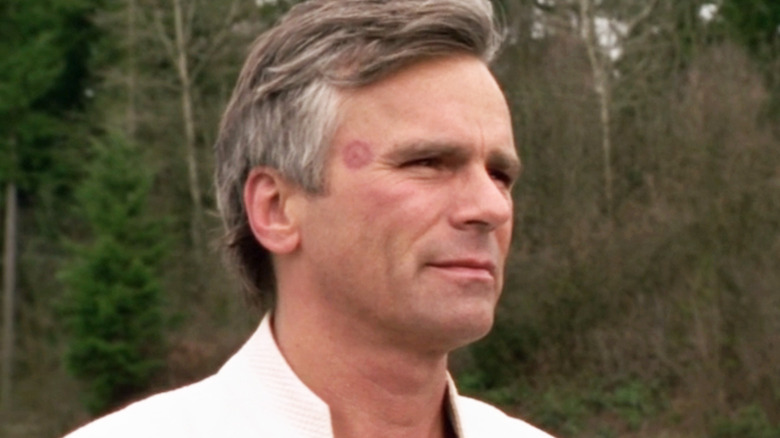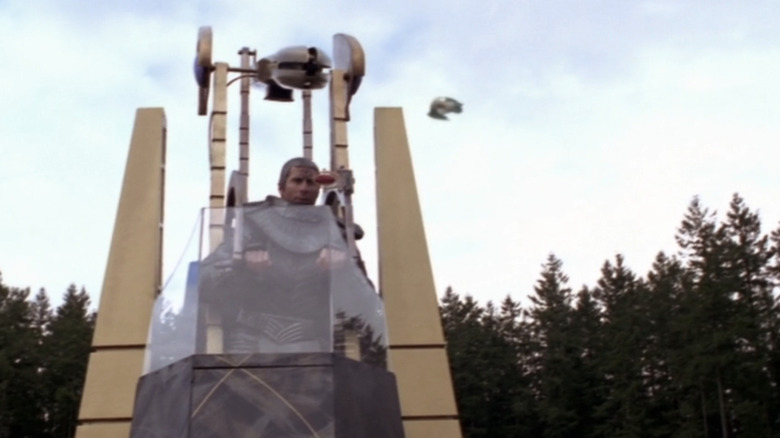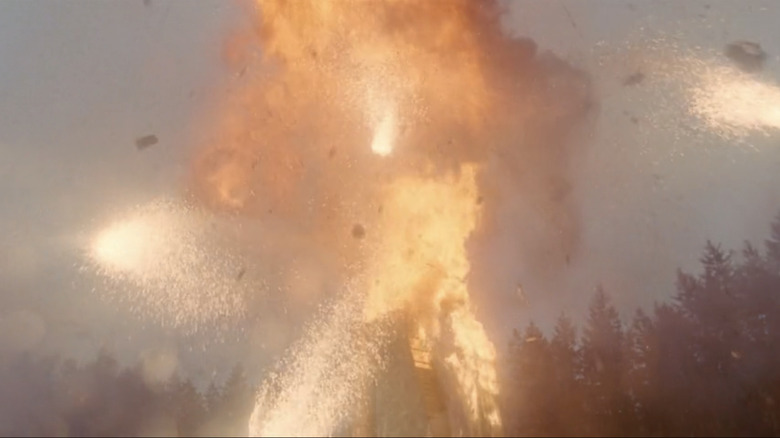An Explosive Stargate SG-1 Stunt Didn't Go As Planned
There have been numerous on-set accidents in the history of film and TV, some of which have been minor, some of which have been outright disasters. Back in the lawless days of pre-code moviemaking, John Wayne was almost killed on the set of Michael Curtiz's "Noah's Ark" when 15,000 tons of water was dumped on a flimsy temple set, resulting in the death of three extras and dozens of injuries. There have since been similarly horrific examples of on-set accidents that have resulted in actors dying on-set and crew being horribly injured. Lamentably, these accidents still happen today.
Then, there are the less tragic examples. One of the most intense scenes in 1992's "Batman Returns," for example, broke an explosive world record that also resulted in four stuntmen being treated for minor injuries. On the TV side, it seems "Stargate SG-1" had its own issues with explosions that thankfully didn't result in any injuries but certainly surprised the cast and crew with how extreme it was.
Stargate SG-1 went a little overboard with a season 3 explosion
The "Stargate SG-1" VFX team has to deal with multiple problems. In a show about a crew of intergalactic explorers who travel the universe by way of a portal that can transport them to previously unknown planets, one of the biggest challenges faced by "SG-1" was finding new locations on which to shoot. After all, the Vancouver base of operations didn't exactly lend itself to depicting a variety of alien worlds. In order to convincingly portray the exploits of the SG-1 crew, then, the show had to rely on some ingenious location scouting and a lot of VFX work.
But there were plenty of other VFX problems faced by the "SG-1" cast and crew. Take the season 3 premiere, "Into the Fire," which ended with an explosion that caused much more damage than anyone expected. In the episode, the SG-1 team is taken captive by the Goa'uld queen and her minions, who imprison them on the planet Eskal. During the climax, Richard Dean Anderson's Jack O'Neill manages to kill the Goa'uld queen and escape alongside his fellow crew members, only to be confronted by Jaffa warriors guarding the Stargate. Thankfully, Christopher Judge's Teal'c and Don S. Davis' General Hammond manage to commandeer a Needle Threader fighter ship, which they then fly through the Stargate and use to start raining hell down on the Jaffa. At one point, they even blast a Jaffa staff weapon tower, blowing it to pieces, and it seems this was where the problem came up.
Speaking to Dial the Gate (via Gateworld), director Martin Wood explained that the "SG-1" production team used a little too much firepower to depict the destruction of the weapon tower. "We used too much detonation cord in that," Wood recalled. "And I remember [special effects supervisor] Wray Douglas saying to me, '... We should probably move back.'" Douglas' warning turned out to be prudent.
Blowing up a Jaffa weapon tower didn't go to plan
In his Dial the Gate interview, Martin Wood explained how the "Stargate SG-1" crew went a little too far when it came to blowing up the Jaffa weapon tower during SG-1's escape from Eskal. "This [tower] was made out of wood," explained the director, "and I said, 'Ok. Are the cameras OK?' And [Wray Douglas] goes, 'Unmanned, they're OK.'" After this, Wood and the crew set up the cameras for a locked-off shot of the explosion before placing them behind protective shielding and retreating from the set. He continued, "We move back. And [Douglas] goes, 'I think we should get behind the trucks.' There are special effects trailers there — and we got behind [them] and he goes, '... Behind the wheels of the trucks!'"
After what Wood described as a "massive explosion," the director recalled looking at the footage and being disappointed that the tower blew up so quickly. The director said the wood was essentially "atomized," which meant the VFX crew had to go back and add larger pieces of debris in post-production. Wood also explained the difference between certain types of explosions, detailing how detonation cord creates a bright explosion that burns white and causes a loss of detail — as was the case with the Jaffa weapon tower. In other cases, he and his team used gasoline. "It's one of the reasons you use gas bags," he noted, "literally a plastic bag filled with gasoline, because gasoline burns yellow rather than that white explosion that you get sometimes when you use just straight det cord."
As far as unplanned mistakes go, this was hardly a horrific event. But "Stargate SG-1" had its share of other accidents, including the time Richard Dean Anderson was stabbed on-set.


